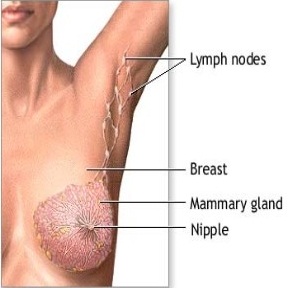



You may have heard others mention a stage of cancer. Have you wondered what that means? Here’s a quick overview: there are five stages, stage 0 refers to a cancer that is non-invasive and remains in its initial location, while stage 4 describes invasive cancers that have spread from the original location to other parts of the body. Then what about stage 1 breast cancer?
A stage 1 breast cancer diagnosis means the cancer cells have broken through the initialboundaries and are invading into tissue surrounding the cancer area. If you have stage 1 breast cancer, you will be told the category of either stage 1A or stage 1B.
In stage 1A breast cancer, your tumor measures up to 2 centimeters and has NOT spread beyond the breast. Your lymph nodes are still free from cancer.
In stage 1B breast cancer, you have no tumor, but the cancer is in smaller groups of cancer cells that are between 0.2 and 2 millimeters in the lymph nodes. You may or may not also have a tumor in the breast that is less than 2 centimeters.
Your stage 1 breast cancer may also have microscopic invasion. In microscopic invasion, the cancer cells are just starting to invade tissue outside the lining of the duct or lobule, but the group of invading cancer cells measure less than 1 millimeter.
You should be doing monthly breast self-exams. These exams will help you to be familiar enough to notice any changes. Consult with your healthcare provider if you find an abnormality.Butfinding something different doesn’t automatically mean you have cancer.
Feel your breast and surrounding areas, including the underarms for a lump or any areas of thickening of the skin. Also check for nipple tenderness or textural differences in the skin of your breast. This could include an enlarging of the pores or dimpling, which might make your skin appear similar to citrus peel. Remember if you find any of these symptoms, contact your healthcare professional and remember not all lumps are cancerous.
Watch for any unexplained changes in size or shape, dimpling, swelling or shrinking (especially if it affects only one of your breasts). Also, if you notice an asymmetry between the two breasts that has not previously been the situation. As far as your nipples, watch for any turning inward or inverting, or if the nipple becomes red, swollen, scaly or forms ridges or pitting.
And, if you have any milky discharge and are not breastfeeding, have that checked too, although it is unlikely to be connected to breast cancer, it should be checked by your healthcare professional.
With proper treatment, you have every chance to recove. Then you may wonder what the stage 1 breast cancer treatments are available. In a matter of fact, there are six possibilities.
Undergoing surgical procedure for stage 1 breast cancer is a necessary. If the tumor is small, you can undergo lumpectomy. In this procedure, the tumor and the surrounding tissue are all removed. However, some women decide to get mastectomy or the process in which the whole breast is removed. The surgeon may likewise remove one or more of the lymph nodes. If you have a mastectomy, you could have reconstructive surgery later.
Want to know more about treatment options for early stage breast cancer? Check out this video: